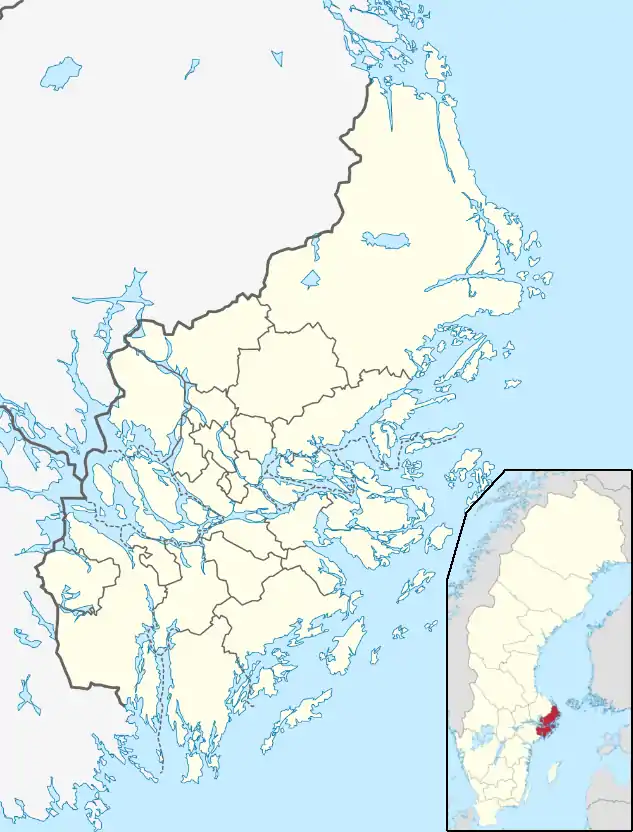Economy Museum - Royal Coin Cabinet
Ekonomiska museet - Kungliga Myntkabinettet | |
 | |
 Location within Stockholm | |
Former name | Royal Coin Cabinet – The National Museum of Coin, Medal and Monetary History |
|---|---|
| Established | 1786 |
| Type | Numismatic museum |
| Website | ekonomiskamuseet |
The Economy Museum - Royal Coin Cabinet (Swedish: Ekonomiska museet - Kungliga Myntkabinettet) is a museum in central Stockholm, Sweden, dedicated to the history of money and economic history in general.
Function
The Economy Museum is an institution with a national responsibility for the conservation and the historical studies of coins, medals, and finance in general. Through expositions, the institution offers insights in the economical history of the world; by lending objects from its collection to researchers and expositions all over the world, it helps develop the knowledge within its scope; and by maintaining a national register of coin hoards, it is of great importance to scholars in Sweden.[1] Over the portal is a piece of art by Elisabeth Ekstrand from 1996 called Vattenporfyrlek ("Water Porphyry Game") made of porphyry and marble. The museum includes exhibitions of coins, banknotes (the first in the world was issued in 1661 by Stockholms Banco), treasure hoards and piggy banks.
History
The Economy Museum's collection dates back to around 1572 when Rasmus Ludvigsson began collecting old Swedish coins. Over the next few centuries, the royal collection grew with donations from royals.
In 1786, the Royal Academy of Letters was established and took ownership of the collection. In 1846, the collection was exhibited publicly for this first time at the Ridderstolp House at Skeppsbron. In 1865, the Royal Coin Cabinet collections was moved into the National Historical Museum. The collection was exhibited there until it moved to another building in Östermalm between 1938 and 1948. From 1899 to 1929, numismatist Rosa Norström expanded the collections.[2][3]
In 1996, the museum was moved to Slottsbacken in Stockholm's Old Town. It changed its name from "Royal Coin Cabinet – The National Museum of Coin, Medal and Monetary History" to "Royal Coin Cabinet – National Museum of Economy." In 2017, the museum closed and, in 2019, reopened in the Swedish History Museum's building.[4][5]
Theft
In 2013, the museum discovered that it was missing items from its collections. After launching a police investigation and taking inventory, they found that 1,200 objects with a reported value of 25 million SEK were missing.[6] The museum's last audit had been conducted in 1997 when the museum moved to its location in Old Town.[7]
In 2017, a former curator of the museum was sentenced to three years in prison for stealing and selling items from the Royal Coin Cabinet and Museum of Gothenburg.[6] In 2020, another former employee was acquitted for the possession of stolen coins. The man had sold about 200 coins but prosecutors could not prove that they were stolen from the museum.[8] The ruling was upheld on appeal because the prosecutors could not prove the acts were not statute barred.[9] 11 items were confiscated during the 2017 indictment and returned to the museum.[10]
Notable collections
- The oldest Swedish coin
- A copper plate coin dating from Queen Christina's reign in 1644 that is thought at 19.7 kg (43 lb) to be the heaviest in the world
- Parts of the Lohe treasure found in 1937 in Gamla Stan
- Weimar Republic inflation currency
- Nobel Prize medals
References
- "The museum and the mission". Economy Museum - Royal Coin Cabinet. Archived from the original on 2006-12-20. Retrieved 2020-10-06.
- Sylloge of Coins of the British Isles. British Academy. 1991. p. 6. ISBN 978-0-19-726090-6.
- Becker, Carl Johan (1981). Studies in Northern Coinages of the Eleventh Century. Kommissionœr Munksgaard. ISBN 978-87-7304-112-3.
- "History of the Museum". Ekonomiska Museet. Retrieved 2022-03-17.
- "Welcome back!". Ekonomiska Museet. Retrieved 2022-03-17.
- Kampmann, Ursula (2018-12-18). "Further Thefts at Royal Coin Cabinet Brought to Trial". CoinsWeekly. Retrieved 2022-03-17.
- Backe, Annika (2017-04-25). "Theft at the Stockholm Royal Coin Cabinet". CoinsWeekly. Retrieved 2022-03-17.
- "Man acquitted of selling stolen coins from museum". Sveriges Radio. 2020-02-26. Retrieved 2022-03-17.
- Svensson, Petter (24 January 2022). "Åtalades för att ha sålt ovärderliga mynt från Myntkabinettet - frias på grund av preskription". Norstedts Juridik (in Swedish). Retrieved 2022-03-17.
- "The Museum's Missing Objects". Ekonomiska Museet. Retrieved 2022-03-17.
External links
 Media related to Kungliga Myntkabinettet at Wikimedia Commons
Media related to Kungliga Myntkabinettet at Wikimedia Commons- Official site in English